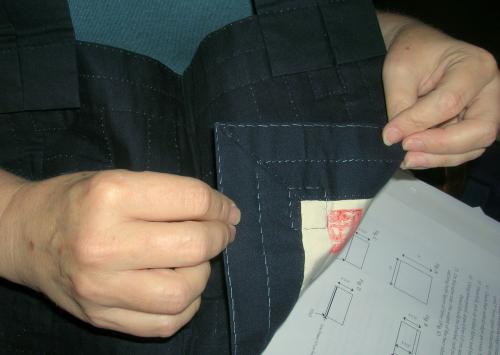
Jean’s hands, Jean’s handiwork. And Jean, inspired sewing teacher at Berkeley Zen Center. Detail of the Namu Kie Butsue Stitch on face and reverse side of the small kesa in the Shunryn Suzuki Linage.
“namu” Means “homage”
“ki” means “to plunge in”
“e” means “to rely on”
In English Namu Kie Butsue translates as “I take refuge in Buddha”
With every stitch made during sewing the small kesa the refuge in recited, I’m presuming silently.
While the small kesa I wear and Jean wears are sewn quite differently, mine machine stitched and hers hand stitched, there is not a stitch that separates in the deepest sense. A few hours sitting in her sewing class was a very relaxing end to a magnificent morning when we celebrated the Festival Memorial for Zen Master Dogen, who extols us to study in detail.
As well as being introduced to several nifty sewing aids I learned, under Jeans compassionate tutelage, how to sew the Namu Kie Butsu (kyakushi)Stitch. Having a teacher rather than following instructions was a real boon. What really impressed me however was the attention to detail at every level, and at every step in the process, of sewing the small kesa. There’s much to take note of.
I’ll probably sew a full kesa by hand one of these fine days and I’ll be using the stitch I learned today. And I’ll remember with fondness the balmy summer afternoon I spent sewing with fine company.
Bows of gratitude to Jean Selkirk compiler of Buddha’s Robe Is Sewn, instructor, and all round enthusiast for attention to detail.
See also, Buddha’s Kesa Is Lived.

I love these little gems of teaching I find here every time I drop by on this blog. I feel I ought to put some comment to acknowledge I have seen it but most times its seems better to take note and move on.
Thank you, Rev. Mugo.